Louisa O’Murphy: Louis XV’s Irish mistress
Published in 18th–19th - Century History, Features, Issue 1 (Jan/Feb 2006), Volume 14
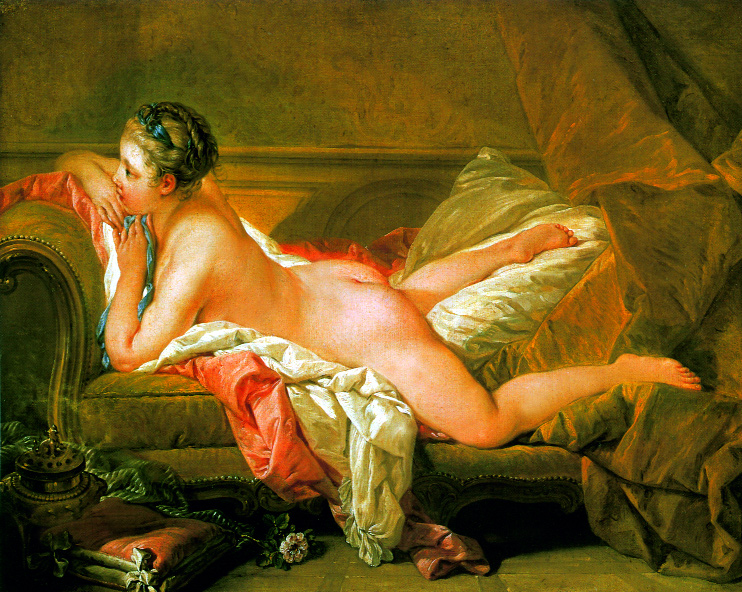
Louisa-painted here in Franí§ois Boucher’s Blonde Odalisque (1752)- first gained recognition, like her sister Victoire, as a model at the Academy of Painting, Paris. (Munich, Alte Pinakothek)
In 1754 the British ambassador in Paris recorded:
‘Sir, Mlle Murphy was brought to bed of a boy last Sunday, at the castle of Versailles… it is kept private as yet, and only whispered in confidence. Whether this will occasion a revolution with respect to the reigning favourite, will be known in a little while.’
While such a revolution was averted, the Irish demoiselle Louisa O’Murphy, or Morphise as she was known at the French court, was the dominant petite maîtresse of Louis XV, outlasted only by the declared mistresses, Mme de Pompadour, her contemporary, and later Mme du Barry.
Louisa, or Marie-Louise, came to the attention of the king through circuitous social connections. She gained recognition, like her sister Victoire, as a model at the Academy of Painting in Paris. François Boucher’s portrayal of Louisa in La Blonde Odalisque (opposite) and of Victoire in La Brunette Odalisque attracted attention to the young Irish girls. They had arrived in Paris in 1741, apparently upon the death of their father, Daniel Murphy, formerly a soldier in an Irish regiment of the French army, who had settled in Rouen as a cobbler. Their mother, Margaret Murphy, née Hickey, appears to have been the ambitious type, who recognised the social potential of at least one of her five daughters and knew that Paris, rather than Rouen, was the place to fully realise it.
It is unclear whether Margaret Murphy—or Marguerite O’Morphi, as she styled herself upon arriving in Paris—left Rouen a widow or not. It would have been highly unusual for a woman to leave her husband and take her five daughters to Paris to further their ‘careers’—indeed, it would have been unacceptable. This question is raised by the observations of the marquis d’Argenson, who mentions in his memoirs that Daniel Murphy was currently (1753) a cobbler in Rouen, a fact uncovered by investigations into Louisa’s background by royal agents. Nancy Mitford also claims (most likely apocryphally) that Daniel Murphy was still alive at this time, allegedly reacting badly to his youngest daughter’s affair with the king, exclaiming, ‘Ah me, among all my girls not one is virtuous’.
Models at the Academy of Painting
Another possible reason for the girls’ move to Paris was the fact that the eldest daughter, fifteen-year-old Marguerite (b. 1726), became the mistress of a M. Meusiner, a friend of Giacomo Casanova, around the time of her father’s apparent death. While this was a secure financial future for the eldest O’Murphy, her sisters and mother still had to earn a living. While their mother operated a second-hand clothes stall near the Palais-Royal, the girls found niches in the wide Parisian underworld. The potential roles in Parisian society that were open to the O’Murphy girls ranged from ‘kept mistresses’, to actresses or femmes galantes to ordinary prostitutes, of whom there were about 20,000 in Paris at this time. Even the pockmarked Brigitte found employment as a hand model, while the other girls either found a domestic arrangement or entered the Academy of Painting as models.
Louisa chose the latter. It proved to be a lucrative occupation, not for the monetary return but for the society to which she was introduced. The principal painter at the Academy was François Boucher, and he soon employed Louisa as his chief model. Boucher is thought not to have used any other model after Louisa, instead relying on his memory of her for future paintings.
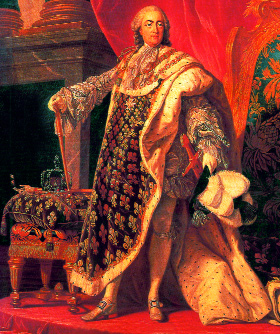
Detail of Louis XV in majesty by Van Loo. (Wallace Collection)
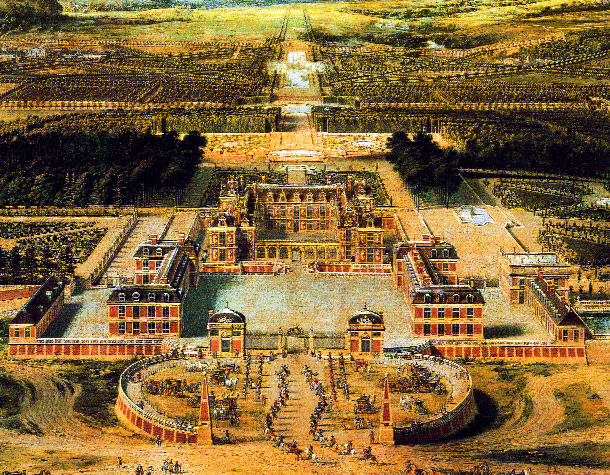
Vue du chí¢teau de Versailles en 1668 by Pierre Patel. The king’s petites maí®tresses were accommodated in inconspicuous houses nearby. (Réunion des Musées Nationaux)
Although the relationship between Boucher and Louisa has not been clearly defined, she may have been his lover for a time. Although married, Boucher followed his wife’s example by taking lovers, and it seems that Louisa was among them. Their affair was short-lived as she soon gained a reputation as one of the prettiest models at the Academy, a recognition that prompted Mme de Pompadour, the declared mistress of the king, to commission Boucher to paint the Holy Family in the queen’s oratory, with Louisa as the Madonna, through which she came to the notice of Louis XV.
Louis XV, the ‘well-beloved’
Louis XV was known as the ‘well-beloved’, and although his recovery from a serious illness had prompted this nickname, it seemed to fit his extramarital activities more aptly. Like his great-grandfather, Louis XIV, whom he had succeeded at the age of five, Louis XV re-established the position of the royal mistress. Under Louis XIV the presence of a declared mistress was continuous; the arrival of a new mistress signalled the departure of her predecessor. Over the years Louis XIV’s mistresses included Marie Mancini, the niece of Cardinal Mazarin; Louise de la Vallière; and Mme de Montespan, whose husband, refusing to capitalise on this traditionally accepted honour, staged a mock funeral and launched into full mourning for his wife. Louis XIV’s last mistress was Mme de Maintenon, whom he secretly married in late 1683 or early 1684, following the death of the queen, Marie Thérèse. Louis XIV had himself followed the example of his predecessors; other prominent mistresses at the French court had included Gabrielle d’Estrées and Diane de Poitiers in the sixteenth century.
Louis XV had added a new dimension to kingly vice, however. As well as keeping an official mistress, Mme de Pompadour, he opened the Parc-aux-Cerfs. While Louis XIV’s confessor, Père de La Chaise, often absented himself from court during Easter to avoid directly refusing the king absolution and was rumoured to give the king unconsecrated communion hosts on account of his debauched behaviour, Louis XV himself refused to take communion, possibly troubled by his own conscience.
Louisa’s installation at the Parc-aux-Cerfs, which had become known as the king’s private harem, occurred in 1752–3 and, considering later events, was an ill-judged move by Mme de Pompadour, who, while no longer occupying the king’s bed, remained his closest female companion until her death. It was alleged that she acted as procuress of Louis’s passades (brief affairs), although this has been refuted by many biographers. Whether she played any decisive part in the particulars of the king’s private life remains debatable; what is certain, however, is her close observation and ‘supervision’ of the petites maîtresses.
Secret door
The Parc-aux-Cerfs was an otherwise inconspicuous house near the palace at Versailles. Over the years two houses were used for the purpose, one on the Rue d’Anjou and the other on the Rue St Médéric; the latter was purchased in November 1755, after Louisa’s departure. It would seem that the girls were sometimes brought from the Parc-aux-Cerfs to the king’s quarters in a sedan chair with closed windows. The comte de Saint-Priest noticed: ‘I have seen several arrive under the little vault where one opened a secret door which led by a hidden staircase to a room next to the king’s suite’.
While a number of girls stayed at the Parc-aux-Cerfs throughout this time, it was soon acknowledged that Louisa was the most prominent of them. Her rise in the king’s estimation was swiftly noted. In May 1753 the marquis d’Argenson recorded: ‘The little Morfi knows how to pay pretty compliments to the king and it is said she will be made his declared mistress’. By the end of the year the papal nuncio, Durini, noted in his journal that ‘the reign of Mme de Pompadour is over . . . The new Irish star is going to Fontainebleau where they have prepared rooms for her; she has received diamonds and magnificent dresses’, and that ‘Her emergence at full daylight was awaited by the nobles and the courtiers’.
Although Louisa was never formally introduced at court, the rumours of her possible arrival were detrimental to the position of the aforementioned reigning favourite, Mme de Pompadour, who continually had to reinforce her standing with the king in the eyes of the courtiers. Paradoxically, an introduction to the young Irish mistress became in itself a higher mark of approval, despite her exclusion from the court.
The strongest challenge to Mme de Pompadour followed the birth of Louisa’s first child by the king in 1754. The birth of children to the king’s mistress posed several problems. Not only did it confirm the liaison, thus strengthening the mistress’s position, but it also created a parallel royal line, albeit illegitimate. The worst-case scenario regarding royal illegitimate children was the possibility that they could become the focus for internal divisions or opposition to the king should the monarchy experience weakness or instability. It was a double blow to the maîtresse en titre, as the death of her own daughter, Alexandrine, at the age of ten occurred in the same year. Pompadour had had high hopes for her daughter at the court, and had expected her to make an advantageous marriage in the upper aristocracy, if not within the princes of the blood, the members of the wider royal family.
Despite the fears of some and the hopes of others, the birth of a son to Louisa and the king did not bring about any ‘revolution’ in the position of the reigning favourite. The child was taken away from Louisa, who was misled into thinking that the infant had died. Indeed, some observed that the king was losing interest in the Irish girl by this time. In January 1754 d’Argenson remarked that ‘the king has taken a new mistress, even prettier than the little Morfi. She’s a brand-new girl and from an even lower social rank, if that were possible, than the last two.’
Louisa’s social origins
While Louisa may have lost favour for a time, she soon returned to her former status. What is interesting about d’Argenson’s comment, however, is his reference to Louisa’s social origins. These would certainly affect her chances of becoming the king’s maîtresse en titre, although the court had been reluctantly flexible in their ultimate acceptance of Mme de Pompadour, a member of the petite bourgeoisie. Her background was a departure from the traditional pedigree of mistresses, who usually hailed from the mid- to upper echelons of the aristocracy, impoverished or otherwise.
Mme de Pompadour owed her royal and aristocratic connections to her involvement in the intellectual society and salons of Paris, through which she gained access to the court. Louisa, on the other hand, had no similar claims to belonging to any respectable society. Her mother had recognised this social disadvantage and, besides changing her name on arrival in Paris, had also tinkered with the lineage of the family, claiming that her husband was of noble birth, namely an O’Murphy of Ballymore (where?). While Louisa’s standing as a petite maîtresse was suitable to her background, her elevation to maîtresse en titre would inevitably have ignited an unacceptable scandal, despite the triumph of Mme de Pompadour, or Jeanne Antoinette Poisson, as she was formerly known.
The ascendance of Jeanne Bécu, Madame du Barry, provoked as much outrage. She was the illegitimate daughter of a seamstress and a ‘fun-loving’ monk, who took her name from her procurer’s brother. The death of Mme de Pompadour removed the main obstacle for Mme du Barry; one wonders whether Louisa might also have become the declared mistress had she faced a lesser opponent.
A second child was born to the king and Louisa in 1755—a daughter who, like the first child, was never seen by Louisa, if she was indeed aware of her existence. The child, Agathe-Louise Saint-Antoine de Saint-André (combining the first names of the king’s two mistresses), was brought up by sisters of Saint-Périne in a convent of the Presentation Order at Chaillot, from which she was removed on her eighteenth birthday, when she was duly recognised by her father on 26 November 1773. It is unclear whether her mother’s identity was revealed to her; it was quite possible for the king to recognise his children without naming their mother, a precedent that had been set by his great-grandfather, Louis XIV, in the legitimisation of his children with Mme de Montespan.
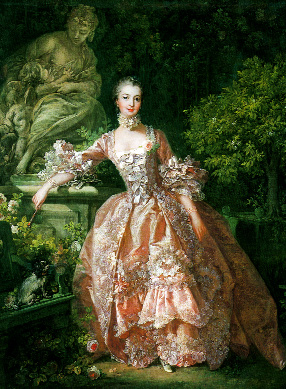
Boucher’s Madame de Pompadour (1759), the king’s ‘official’ mistress and Louisa’s rival. (Wallace Collection)
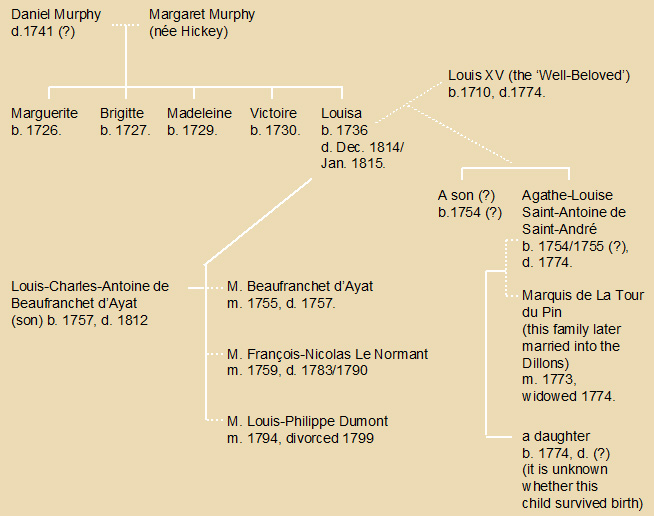
Louisa’s family tree
Following the revelation of her paternity, Agathe-Louise found her hand in marriage eagerly sought after. Initially Mme du Barry schemed to have her married to her nephew, a match that was rejected in favour of marriage to the marquis de La Tour du Pin, whose family later acquired Irish connections through marriage to Henrietta-Lucy Dillon. Louisa’s chances of reconciliation with her daughter vanished with Agathe-Louise’s death in 1774, owing to complications arising from pregnancy.
By this time Louisa had long departed from the court. Many identified her bold questioning of the king about his relationship with his vieille coquette (old flirt) as her final downfall. When word of this disrespect reached Mme de Pompadour, she demanded the girl’s dismissal and arranged a marriage for her immediately. On 27 November 1755 she was married to Monsieur Beaufranchet d’Ayat, a poor but noble army officer of Auvergne. Louisa’s origins were disguised, and Beaufranchet was informed that she was a member of a very distinguished military family that had fled Ireland following the surrender of James II in 1691 and had loyally served the army of Louis XIV. The marriage was not only financially attractive but the middle-aged army officer was also promptly promoted to Colonel d’Infanterie Jacquaide, and then to Mayor de l’Armée de Soubise. In monetary terms, Louisa was accompanied by an exceptional dowry of 200,000 livres, as well as a generous trousseau.
Widowed
The death of Beaufranchet at the battle of Rosbach on 5 November 1757 left Louisa widowed on the eve of giving birth to their first child, Comte Louis-Charles-Antoine de Beaufranchet d’Ayat, born on 22 November. The child was rumoured to be more Bourbon than Beaufranchet, gossip generated by Louisa’s continuing, if intermittent, contact with the king, and perhaps by Louis’s acting as the boy’s godfather. She was reputed to be involved in the management of the Parc-aux-Cerfs, where her sister Brigitte is believed to have succeeded her. In any case, Beaufranchet was never recognised by the king, and Mme de Pompadour, fearing that the newly ‘liberated’ Louisa might pose a renewed threat to her position, took a hand in arranging another marriage, this time to a cousin of Mme de Pompadour’s estranged husband, Charles Guillaume Le Normant d’Etioles. François-Nicolas Le Normant was at the time a finance official at Reims, but, like his new wife’s first husband, his career benefited quickly from his marriage. Shortly after the wedding he was appointed Trésorier de l’Ordre du Saint Esprit, which empowered him to levy first fruits on court and state appointments.
Louisa remained a threat to Mme de Pompadour’s position and her return to court was rumoured on various occasions, even upon the death of the reigning mistress in 1764. However, with the accession of Mme du Barry and the death of the king in 1774 Louisa’s only possible connection with the monarchy was severed. She maintained a comparatively anonymous life with her second husband, who left her widowed once again in 1783. Upon his death she was granted a generous royal pension, which she held until the outbreak of revolution in 1789.
The Terror
Despite the distance between Louisa and the ancien régime, she was arrested during the Terror for her past association with the monarchy. Her return to her maiden name in order to identify herself with other Irish exiles caught up in the revolution failed to divert attention from her past alliances. Her son Beaufranchet had by this time been successful in the ranks of the élite regiments of the army. Upon the outbreak of the revolution he adopted the principles of the revolutionaries and joined the National Guard, through which he rose quickly; he was a general by the time of Louis XVI’s execution in January 1793. Several apocryphal accounts credit him with ordering the drum-roll to muffle the king’s last attempts to address the people, when in fact it was the instructions of Santerre, the commander-in-chief of the National Guard, that silenced the king.
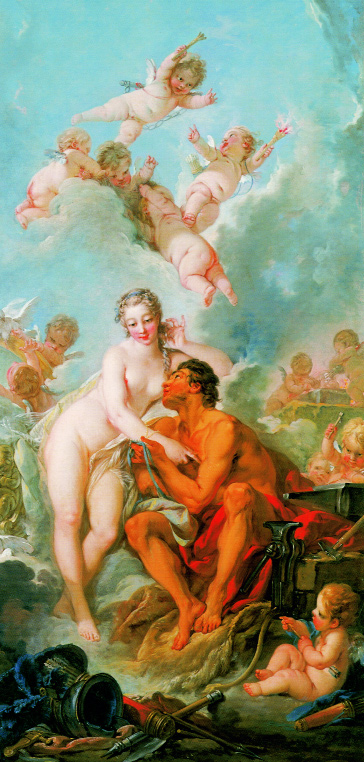
Louisa in Boucher’s Venus and Vulcan (1754). Boucher is thought not to have used any other model after Louisa, instead relying on his memory of her for future paintings. (Wallace Collection)
Although Beaufranchet was prominent in the National Guard, he did not, or perhaps could not, ease his mother’s situation. She remained imprisoned for two years alongside other women identified with either the old regime or ‘counter-revolutionary’ ideals, including Mme Péton, wife of the mayor of Paris, Mme Brissot and Lucille Desmoulins, wife of Camille.
In 1794 Louisa married for the third time. This marriage coincided with her release from prison but it is unclear whether it actually facilitated it. Her third husband was a young revolutionary, apparently a guard at the prison, who was twenty years her junior. Louis-Philippe Dumont remained her husband until 1799, when he divorced her, for reasons unknown.
Louisa continued to live in Paris until her death. Her son Beaufranchet, following distinguished service to Napoleon, died childless in 1812. While the dates of Louisa’s death are disputed (11 December 1814 or 17 January 1815), it is likely that she witnessed the return of Louis XVIII to Paris in May 1814.
Louisa, as the daughter of an exiled Irish soldier, was an exceptional, if perhaps outrageous, member of the Irish émigré community on the Continent in the eighteenth century, and one who led an extraordinary life both within and without the French court. The British ambassador’s comment that she was ‘no more than a fantasie passagère that will not hold long’ was inaccurate regarding her tenure as a ‘petite reine de la main gauche’ as she held the position longer than any of her counterparts, and, unlike her counterparts, her life away from the king merits as much attention as her life with him.
Linda Kiernan currently tutors in Trinity College, Dublin, St Patrick’s College, Drumcondra, and University College Dublin, where she is completing a PhD in history.
Further reading:
D. Clarke, Louison: the life and loves of Marie-Louise O’Morphi (Belfast, 1979).
O. Hufton, The prospect before her (New York, 1995).
C. Pevitt Algrant, Mme de Pompadour (New York, 2002).
J.-F. Solnon, Histoire de Versailles (Paris, 1997).
















